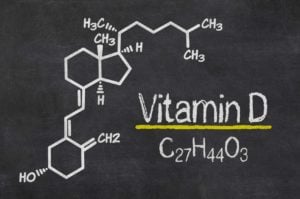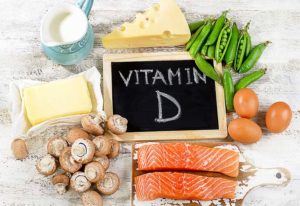To understand vitamin D, we must …
first figure out what a vitamin is, and that will take us to the secret la-BOR-atory of mad scientist, Casimir Funk, a Polish biochemist who in 1912 screamed, “Igor, I’ve found it!” when he realized why people who ate brown rice did not develop beriberi, but people who ate white rice did. He discovered a family of chemicals in brown rice that are good for you. Dr. Funk named these new substances “vitamines.” Vita = Italian for “life” or “pasta” and -amines for nitrogen and carbon containing molecules, which these were. Later, the “-e” was dropped because not all vitamins have an amine group, and the term vitamin was created.
Vitamins are complex molecules that we must have to stay healthy—but we can’t make them ourselves—so we have to obtain them from food. Most humans make their own insulin, so it’s not a vitamin, unless you’re a type 1 diabetic. If you get plenty of sunshine, then vitamin D is not really a vitamin because you can make it yourself in the skin. Irony upon ironies is that Casimir Funk’s father was a dermatologist and it is those nutty dermatologists who keep telling us to avoid the sun, which is one factor leading to an increase in vitamin D deficiency, but to be fair, also a decrease in skin cancer.

When the government began adding vitamin D to milk and other foods in the 1930s, rickets disappeared in the United States. But without the government’s help, we make vitamin D from sunlight. Here’s how: sitting in your skin is a precursor molecule called 7-dehydrocholesterol. Yep, you guessed it; it is a molecule derived from cholesterol. Can you imagine being on Lipitor and vitamin D pills at the same time? Your body is probably wondering, “What the heck are you doing?!” Anyway, it just takes a good zap of UVB sunlight (the kind best blocked by most sunscreens) to turn 7-dehydrocholesterol into a pre-vitamin D molecule that the body can then convert on its own to vitamin D. If only we had one tiny little enzyme that could trigger this chemical reaction instead of depending on sunlight, then the body could make all the vitamin D it needed from a steady diet of high cholesterol Big Macs, and there would be no vitamin D deficiency in the United States. (Scientific note: the amount of cholesterol in the body is so much greater than the vitamin D that even in patients with very low cholesterol, we don’t think this causes or contributes to vitamin D deficiency).
Vitamin D exists in two related forms: D2 and D3. Plants are the typical source of D2 and animals of D3. The reaction from sunlight gives us both. Some research suggests that vitamin D3 taken orally is more beneficial, but this is controversial. Either form circulates in the body stuck to a carrier protein called vitamin D binding protein. These forms of vitamin D are still precursors to the active hormone and neither does much of interest in the body. The liver converts them to 25-hydroxy vitamin D, which interestingly enough, is still an inactive storage form with few biological effects. When we measure your vitamin D level, we’re generally measuring 25-hydroxy vitamin D, also written as 25(OH)D. This storage form of the vitamin is kept in fat and can last in the body for weeks. It’s actually the kidney that takes the storage form of 25-hydroxy vitamin D and converts it to 1,25-dihydroxy D3, sometimes written as 1,25(OH)2D3. That, my friends, is the active vitamin D molecule that we need. The kidney likes having this job because the kidney helps regulate our blood calcium level.
You might wonder about taking the active 1,25(OH)2D3 directly, but in fact we have regulatory mechanisms in place to prevent vitamin D toxicity. Taking the active form would bypass these safety mechanisms and lead to dangerously high calcium levels.[/vc_column_text][/vc_column][/vc_row][vc_row][vc_column width=”1/1″ animation=”fadeInLeft”][dt_gap height=”10″][/vc_column][/vc_row][vc_row][vc_column width=”1/1″][vc_column_text]But what does vitamin D do? It travels to the nucleus of various cells and tells them to make proteins. Its most important job is in the small intestine where 1,25-dihydroxy D3 tells the cells there to make a protein that absorbs calcium from food. That protein is called calbindin 9K. (Cal = calcium, bindin = California surfer dude pronunciation of “binding,” 9K = how much it weighs).
This might seem like a stupid piece of engineering. Why not just automatically make a ton of calcium binding protein and absorb all the calcium we can from the diet? Heck, half the women in the country are eating Tums to get extra calcium, why would you regulate the absorption of calcium? Well, the answer is that too much calcium in the body is just as bad as too little, so we need many mechanisms in place to regulate how much we take in. Maybe you’d argue we should just let the kidney urinate away the extra calcium, which it will do, but at a higher risk of kidney stones.
Vitamin D acts in many other areas. It causes us to make less PTH, a hormone that raises calcium levels by chewing up bone. When vitamin D levels are low, the body knows it won’t be absorbing much calcium from the gut and therefore makes more PTH to get calcium from bones. We need the calcium not just for our teeth and skeleton, but also to regulate the function of nerve and muscle cells. Vitamin D is also thought to help lay down healthy bone. It creates the right environment for cells called osteoblasts (which build new bone) and osteoclasts (which remove old bone) to work.
Vitamin D may also have weak anticancer effects. The problem is that giving patients huge amounts of biologically active 1,25(OH)2D3 causes dangerous elevations in the calcium level. Giving huge amounts of the regular inactive D2 or D3 you buy at the pharmacy just causes it to be stored in fat.
So vitamin D is the main regulator of how much calcium we absorb from food into the body. Normally, we make vitamin D in the skin from sunlight and store it in an inactive form. The body creates more of the active 1,25-dihydroxy D3 when it wants to absorb more calcium from food, and keeps more in the inactive storage form when we have enough calcium. The lack of sunlight (due to sunscreen, living mostly indoors, etc.) leads to lowered vitamin D levels and less effective calcium intake by the body. The widespread fortification of foods with vitamin D2 or D3 has helped mitigate the problem of lower vitamin D being created in the skin. Still, many folks, particularly those living in northern climates like Seattle, continue to have low vitamin D levels.
You can measure the biologically active 1,25(OH)2D3 in the body, but it generally will not fall until vitamin D deficiency is very severe, and also it can go up and down based on many short term fluctuations in body chemistry. The storage form, 25(OH)D is the one to measure.
Most physicians agree that levels under 10 mg/ml are bad for you. These are the levels associated with rickets in kids. Levels around 11-15 are borderline low and might still impair calcium metabolism. Levels above 20 or so used to be considered perfectly fine, but more recently, some authorities have argued for levels above 33 or even 50. The problem is that most patients have levels around 20-30, so depending on where we say normal is, we could be making 90% of the population of Seattle vitamin D deficient. On the other hand, to be safe, we generally aim for levels under 100, with the possibility of toxicity from too much vitamin D becoming an issue for levels in the 200-400 range. At this point, the storage so overwhelms the body that excessive calcium is absorbed from food and blood levels can rise dangerously.
Most of our vitamin D comes
from fortified foods
or sunlight.
Most of our vitamin D comes from fortified foods or sunlight. Unfortunately, if you live north of a line drawn from Yreka in northern California to Boston, you don’t get any vitamin D from sunlight from November to February, unless you vacation in Hawaii. If you’ve ever been to Yreka, well, you probably would want to not only vacation in Hawaii, but also move there permanently. Sunscreen and glass filter most of the UVB and prevent vitamin D synthesis. Air pollution and cloud cover reduce UVB by 50-60%.
Given these limitations, some patients will end up taking extra vitamin D. There is a lack of standardization among different labs on the techniques used to measure vitamin D levels, so they could vary considerably from lab to lab. When supplementation is recommended, the typical doses are 1,000 to 2,000 international units (IU) daily or somewhere around 10,000 units once per week. Prescription strength vitamin D comes as 50,000 units which can be taken weekly as well. I generally recommend vitamin D3 as opposed to vitamin D2. Ultimately, they may be proven equivalent, but for right now, the evidence slightly favors D3 over D2.
But here is the real issue. Outside of truly low blood levels, does all this vitamin D hysteria mean anything? One study of patients over age 62 only showed a benefit for vitamin D supplementation to women who were around 85 and living in a nursing home. In the Women’s Health Initiative trial of 36,000 patients, adding 400 IU of vitamin D and calcium gave women a 1% increase in bone density, but overall did not have a significant effect on their risk of fracture and resulted in no change in the risk of colon cancer. The risk of kidney stones went up. Even under the most favorable torturing and reanalysis of the research data, you would have to treat 5,000 women at age 50 to prevent one fracture. Maybe if these women had taken 2,000 units instead of 400, we would’ve seen a benefit, but could there be some risks as well?

In my practice, I think it is reasonable for patients in Seattle to have 25(OH)D levels measured at the time of their annual exams, but most insurance companies have stopped paying for this test which can run around $90. If the levels are substantially below 20, or under 33 with associated osteoporosis, then I recommend supplements. If the levels are in the 20-30 range, we just are not sure yet if there is a net benefit to taking vitamin D. If you are in the habit of taking vitamins, then you might as well target a level over 30, but if not, I don’t have enough scientific evidence to say it will benefit you. Recently, my vitamin D level was 22 and I won’t be taking any extra vitamin D, but maybe I’ll recheck it in December, just for fun.


